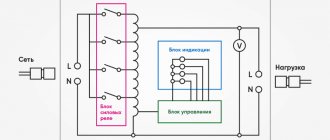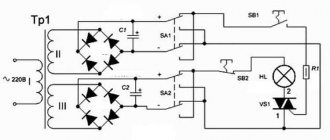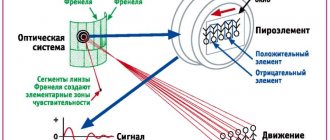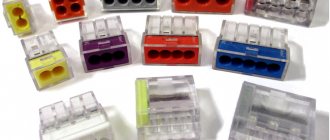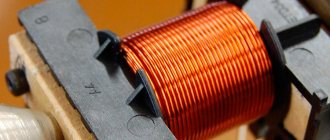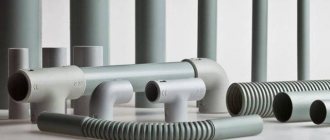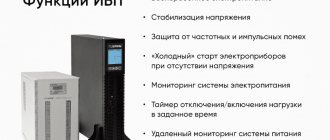Currently, stabilization devices made on microcircuits are widely used in electronics. An integrated voltage stabilizer is a device in which all the elements included in the design are arranged on a silicon chip in such a way that the sequence of these connections and components constitutes a stabilizer circuit.
Such stabilizers can be found in different types of electronic equipment: in amplifiers, in power supplies of televisions, telephones, and audio systems.
Types of stabilizers
Two types of integrated stabilizers are widely used in electronics:
- semiconductor (solid-state);
- hybrid-film (with elements made from films).
Semiconductor stabilizers, in turn, are divided into several groups:
- having adjustable output voltage - require the connection of additional elements;
- having a fixed voltage supplied to the output - they are a ready-to-use product that does not require additional connections to the circuit;
- bipolar – used for devices requiring bipolar output voltage.
Criteria for choosing an electronic stabilizer
When choosing an electronic stabilizer, you should be guided by the following technical characteristics of the device.
| Characteristic | Description |
| Stabilizer power | One of the most important characteristics of a device, regardless of its type, which is determined in accordance with the total power consumption of the connected load. For active loads, it is recommended to select the stabilizer power with a small reserve of 20-30%; for loads with a high reactive component, it is recommended to take a larger power reserve. |
| Stabilization speed | An equally important parameter of the stabilizer. The correction time is almost the same for all models of this type. In terms of stabilization speed, electronic stabilizers are certainly leaders among devices that use an autotransformer to convert voltage. |
| Stabilization accuracy | The indicators of this characteristic are largely determined by the number of discrete control stages - installed semiconductor switches (power thyristors or triacs). The more of them there are in the circuit, the less the stepwise regulation is manifested and at the output the device will be able to produce a voltage with a value closer to the nominal one. |
| Input voltage range | Its lower and upper thresholds determine the minimum and maximum voltage of the supply network at which the device can operate while maintaining the declared stabilization accuracy, as well as protective operation - turning off the stabilizer when the input voltage exceeds the operating range. |
| Working temperature | Electronic stabilizers do not have mechanically switched contacts, so the devices can withstand sudden changes in ambient temperatures well. The choice of device must be made in accordance with this characteristic and operating conditions. |
| Housing versions | The required design depends on the area, geometry of the room, proximity to the location of heating and heating devices. Based on the type of housing, stabilizers can be divided into:
|
| Monitoring tools | Quite popular options are the ability to monitor the state of the network and the operating parameters of the stabilizer, implemented by outputting data to an LCD display or indication LEDs. If it is necessary to organize remote monitoring and control, the availability of communication interfaces and the corresponding data transfer protocols used should be taken into account. |
Characteristics
A typical integrated stabilizer circuit consists of the following elements:
- reference voltage source;
- error amplifier;
- adjustment elements connected between the source and the load;
- circuit for turning off the device when a signal is supplied from the outside;
- transistor for protection against short circuit or overload.
Integrated stabilizer chips are functionally complete devices and have only three external pins: input, output and ground. These microcircuits are manufactured for fixed voltage values from 5 to 24 V and loads up to 1 A.
Stabilization devices on the IC are provided with built-in circuits that limit the output current, as well as an overload protection circuit for temperature.
Advantages and disadvantages of electronic stabilizers
Below are the main advantages and disadvantages of electronic stabilizers compared to relay devices. They are determined, first of all, by the structure and features of the voltage conversion method of electronic stabilizers.
| Advantages | Flaws |
|
|
The value of ION in the stabilizer circuit
The reference voltage source is one of the key elements, since it performs the task of maintaining a stable voltage at the nominal value at the output when the input voltage changes. The simplest version of this source is a parametric stabilizer based on a zener diode. With their help you can get a voltage of 2.5 V.
If it is necessary to obtain lower reference voltage values, series connections of silicon diodes are used.
Also, integrated stabilizers can use the voltage of the emitter junction of bipolar transistors as a source.
Advantages and disadvantages
The advantages of integrated linear voltage stabilizers include:
- high stabilizing coefficient;
- high smoothing coefficient of the load voltage value;
- low output impedance;
- do not produce their own interference.
However, the efficiency of such stabilizers is low and decreases at low output voltages. An increase in efficiency is possible by increasing the size and dimensions of the device, which is not always a convenient and profitable option.
Voltage stabilizer 12 Volt
In situations where using a full-fledged 12-Volt power supply is pointless, it is much easier to lower the main voltage of the circuit locally in some part of it; an integrated 12-Volt voltage stabilizer is used. Such stabilizers are produced on the basis of the domestic KR142EN series or popular microcircuits of the 78XX line.
Such stabilizers are equipped with current and overheat protection, which makes power supplies using them virtually invulnerable. These properties make the stabilizer useful for a number of electronic devices:
- household electrical appliances;
- measuring, laboratory equipment;
- radio electronics, etc.
The stabilizer has such characteristics as the presence of an internal thermal regulation system, a protection circuit for the output transistor, and self-protection against short-circuit pulses. The output current of the device is 1 A - 1.5 A, the highest voltage value is 30 - 35 V.
Inverter voltage stabilizer as an alternative to electronic ones
Due to the disadvantages described above, electronic stabilizers are gradually becoming a thing of the past. They are more expensive than relay devices, but still do not provide sufficient accuracy and quality of the output voltage. As an alternative for domestic use, many are increasingly using inverter stabilizers. They are built on the basis of a more modern conversion method, which eliminates the disadvantages inherent in devices based on triacs and thyristors. In an inverter stabilizer, the voltage supplied to the input is converted to constant, and then again to alternating, but with the required parameters. This ensures the shape of an ideal sinusoid and achieves high stabilization accuracy (2%).
Inverter stabilizers operate almost silently and have a full range of protections - against overloads, overheating, short circuits, and network failures. They are the best option if you need to provide power to expensive devices that are sensitive to power outages - computer equipment, heating systems, electronically controlled boilers, country house security systems.
By purchasing an inverter stabilizer, you can ensure a reliable supply of electricity to all electrical appliances used in the house - from small household appliances to water supply and heating systems. The technical features of the inverter stabilizer make its scope of application much wider than that of electronic models.
Stabilizer 12 V 5 A
An integrated voltage stabilizer 12 Volt 5 Ampere can be based on the LM 338 chip and have the following characteristics:
- input voltage – from 3 to 35 Volts;
- output voltage – from 1.2 to 32 Volts;
- output current – 5 Amperes;
- permissible temperature range – from 0 to 125 degrees Celsius;
- output voltage error is no more than 0.1%.
Such an imported integrated stabilizer is a universal microcircuit, on the basis of which it is possible to obtain high-quality power circuits by connecting it in various ways.
Foreign integrated stabilizers
The well-known 78XX line of positive voltage compensation devices was successfully created by specialists from Texas Instruments. These stabilizers are provided with protection against short-circuit currents, against exceeding the operating temperature of the crystal, as well as against the operating point crossing the boundaries of the operating mode acceptable for safe operation.
In addition to fixed voltage stabilizers, adjustable modifications of integrated stabilization devices are also produced abroad. Prominent representatives of such devices are considered to be the “317” line of microcircuits. The voltage supplied to the output of these microcircuits is determined by a divider on two resistors.
Important points
When using imported integrated voltage stabilizers, it is worth considering some features:
- A capacitor with a capacity of 47 - 220 nF should be connected to the input and output of the device to prevent self-excitation;
- If the capacitor connected to the output has a large capacity and the load current is low, a diode must be connected between the input and output. This will ensure a rapid decrease in the output voltage to the input value;
- for stable operation of the device, the input voltage value must be selected higher than the output voltage by at least 3V;
- devices of the “law-drop” line, characterized by a small voltage difference from input to output, for stable stabilization must be provided with an input voltage that exceeds the output voltage by 0.1 - 0.5 V.
Areas of application of electronic voltage stabilizers
The advantages of electronic stabilizers over relay devices, such as higher speed and accuracy of voltage regulation, quiet operation, reliability and long service life, due to the absence of mechanical switching elements, ensure their widespread use at home to protect household loads that do not contain electric motors, for example, television and kitchen appliances, as well as lighting devices.
A serious limitation in the scope of application of electronic stabilizers is the difference in the shape of the output voltage from sinusoidal, as well as the insufficiently high accuracy of stabilization.
It is highly not recommended to connect high-precision sensitive equipment to electronic stabilizers. For example, certain problems may arise when working with:
- devices that contain an electric motor (pumps, heating systems) - the output voltage of the stabilizer, which has an irregular curve shape, can lead to engine failure;
- professional audio and video equipment - interference created during step switching will negatively affect the quality of picture and sound;
- computer technology - the accuracy provided by stepwise voltage regulation may not be enough.
Thus, it will not be possible to fully provide power to a country house or cottage using an electronic stabilizer, since it will not be possible to power some sensitive equipment with electric motors, for example, water supply system pumps.


